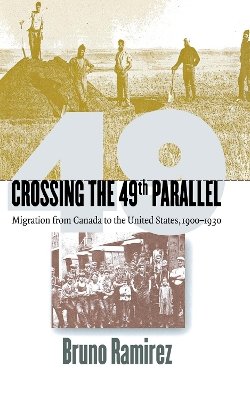
Crossing the 49th Parallel: Migration from Canada to the United States, 1900–1930
Bruno Ramirez
In the hundred years ending in 1930, an estimated 2.8 million Canadians moved south of the 49th Parallel and settled in the United States. The human and technical resources they brought made Canadian immigrants integral to the growth of New England, the Great Lakes region, and the west coast. Crossing the 49th Parallel is the first book to encompass that entire, continent-wide population shift. It brings Canadian migration to the center of both Canadian and U.S. history.
Bruno Ramirez researches the contents of previously unused border records to bring to light the wide variety of local contexts and historical circumstances that led Canadian men, women, and children to cross the border and become key actors in the U.S. economy and society. Ramirez goes beyond these statistical data, consulting qualitative sources and case studies to reveal the motives and aspirations of individuals and family groups.
The comparative perspective of Crossing the 49th Parallel allows Ramirez to explain the distinctive roles of French- and Anglo-Canadians in the immigrant movement. By shifting the viewpoint from a continental to a transatlantic one, Ramirez also unveils Canada's important role in international migration; it served as a temporary destination for many Europeans who subsequently remigrated to the United States.
Product Details
About Bruno Ramirez
Reviews for Crossing the 49th Parallel: Migration from Canada to the United States, 1900–1930
Choice
Above all, the author confirms the porousness of the U.S.-Canadian border in this period period and shows the degree to which both Americans moving north and Canadians traveling south based their decisions to move, not on their nominal citizenship, but on the economic opportunities and social advantages that the transborder regions—seen here as coherent, autonomous entities—could provide. In addition to its other virtues, Crossing the 49th Parallel takes us another salutary step down the road toward the new discipline of diasporic studies.
Journal of American History
Crossing the 49th Parallel is an impressive book with much to offer anyone interested in Canadian or U.S. History.... It is both a pleasure to read and an important contribution to the growing literature on migration within North America.
Great Plains Research
One of the truth strengths of Ramirez's book... is his repeated use of individual accounts to illustrate larger trends n migration patterns.... Part of the story of Canadian immigration to the United States is already known. Cross-border movement in the nineteenth century, particularly in the post-1867 period and specifically by French Canadians, is well known, especially since, in the case of the latter, the new arrivals in the United States stood out from the Anglo majority. Ramirez does an admirable job of sketching out this background in preparation for his focus on the twentieth century and because one of his main arguments is that continuity exists between nineteenth- and twentieth-century immigration patterns.
Canadian Journal of History
Previous studies have dealt mostly with French Canadian patterns, leaving Anglo-Canadians an unknown quantity. In Crossing the 49th Parallel, detailed chapters are devoted to each group. Ramirez examines these groups, giving us statistical information and the impact on both sides of the 49th parallel. And like others who are involved in ethnic studies, he provides personal narratives of immigrants, which add a richness to his book.
New York History
Ramirez draws attention to the large number of Europeans who came to Canada and then moved on to the United States.... He suggest this phenomenon gave Canada a unique place in the Atlantic socio-economic system as half-way house between Europe and the United States....The book combines careful research with sound theory... and is written in an engaging narrative style.
International History Review
There is no question that Crossing the 49th Parallel makes a valuable contribution to the migration historiography of North America. Hopefully it will find its rightful place on the bookshelves and research tables of colleges and universities.
Canadian Social Studies
Few reading this book will not be struck by how many of yesteryear's issues are still with us in one form or another.... And then there were American fears, voices particularly from the early to mid-1900s, over how illegal European immigrants were using Canada as a backdoor for sneaking into the United States.... Crossing the 49th Parallel is well researched and written, a must read for anyone interested in the immigration history and population geography of twentieth century North America.
Journal of American Ethnic History
In Crossing the 49th Parallel, Bruno Ramirez gives us an all-encompassing view of immigration from Canada in the first third of the twentieth century..... Ramirez's analysis of the socio-economic characteristics of the migration, as well as political factors involved on both sides of the border, should interest all genealogists with roots in Canada.
New York Genealogical and Biographical Record
Ramirez goes beyond the statistical data, consulting qualitative sources and case studies to reveal the motives and aspirations of individuals and family groups.... If you had family who are to be found in this migration, you must read it to understand why they came to the U.S.
Western Pennsylvania Genealogical Society Quarterly
